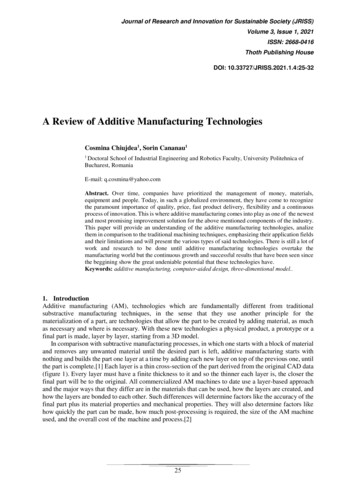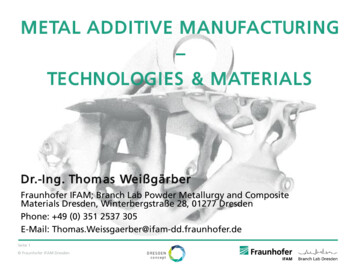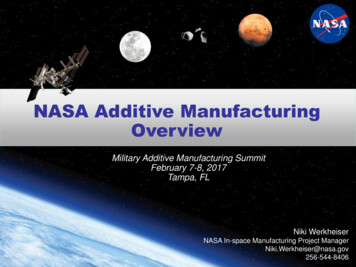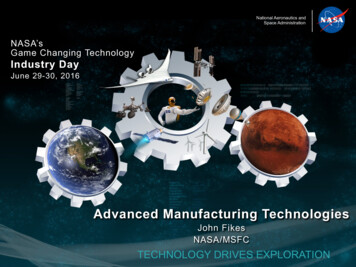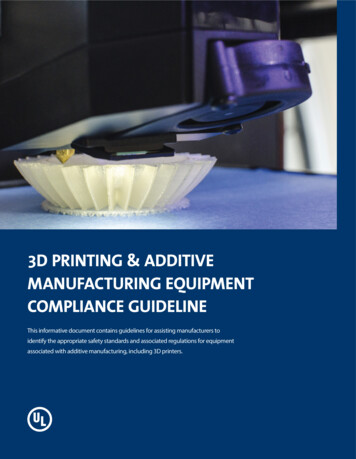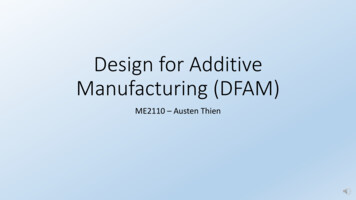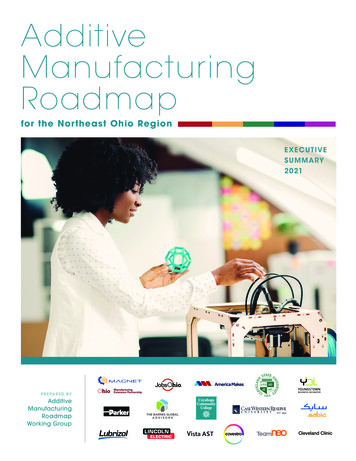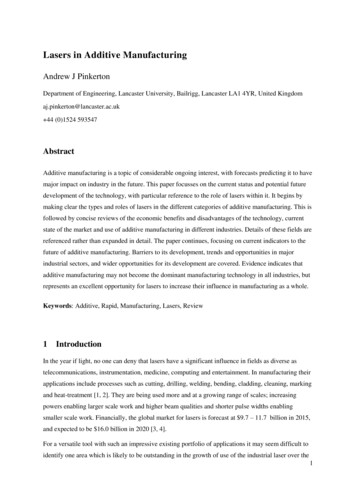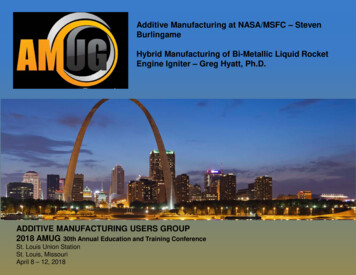
Transcription
Additive Manufacturing at NASA/MSFC – StevenBurlingameHybrid Manufacturing of Bi-Metallic Liquid RocketEngine Igniter – Greg Hyatt, Ph.D.ADDITIVE MANUFACTURING USERS GROUP2018 AMUG 30th Annual Education and Training ConferenceSt. Louis Union StationSt. Louis, MissouriApril 8 – 12, 2018
National Aeronautics and Space AdministrationMarshall Space Flight CenterAdditive Manufacturingat NASA/MSFCTransforming Design & ManufacturingSteve BurlingameAdvanced Manufacturing Assistant ChiefNASA / MSFC
Agenda Our History in AM Our AM Efforts Manufacturing “In Space” Manufacturing “For Space” AM Developments and Goals Hybrid AM Developmental Efforts(Collaboration with DMG MORI – Dr. Greg Hyatt)
Additive Manufacturing History at MSFC Extensive experience in Additive Mfg. (AM) design & process development Experimented with over 30 AM technologies/systems in the past 26 years Capital investments in Powder Bed Fusion hardware, engineering, facilities andtesting ( 56M in the past 4 years). Have the largest commercially available PBF system in Metallic and the largestcommercially available polymer AM system20002010
Additive Manufacturing at MSFCObjectives:To develop, demonstrate and evolve AdditiveManufacturing as a key component of an integrated engineering solution andrisk reduction for affordable manufacturing for space transportation systems,and manufacturing in reduced-gravity environments.For-SpaceIn-SpaceNational Aeronautics and Space Administration
AM Manufacturing “IN-Space”Why is it important?AM is a critical technology for deep space explorations, part replacements, tools andhabitats.3D Print Technology Demonstration First manufacturing capability in Space(International Space Station) Presently have two 3D printers on Space Stationand two more are in works. One of which is a 3Dprinter and recycler (all in one).3D Print Flight Unit with the MSGEngineering Unit in the background
AM Manufacturing “For Space”NASA MSFC is looking to Additive Mfg. and innovative designs to reducemanufacturing cost and schedule and help affordability of access to Space.Major Efforts Include: Implementation of AM components for next generation of rocket engines Characterization of applicable alloys in AM Rationales for flight certification for NASA and our vendors Risk reduction and data share in pursue of smart vendor base Development of new alloys for AM processes (i.e. copper) Next generation AM technologies (Additive/Subtractive System)
MSFC AM Machines: Polymers3D Systems ViperStratasys Fortus 900mc3D Systems SLA 5000
MSFC AM Machines: MetalsConcept Laser X‐Line 1000RConcept Laser M2ARCAM S400VideoEOS M290
Significant Effort in AM ationDimensional &NDE InspectionsProcess ParametersDigital ThreadHeat TreatmentTest & PropertiesSurface FinishMicrostructure
What is MSFC’s Role in AM ? Risk Reduction & Technology TransferVendor Development & Smart BuyerCertification Rationale & GuidanceAnomaly ResolutionImage Credit: Aerojet Rocketdyne
Bi-metallic AM Development Although SLM/Powder Bed Fusion satisfies a lot ofAM manufacturing needs, it has limitations Some limitations: build envelope size, surface finish,speed, component design, multi-materials Some of these issues have been solved anddemonstrated by the following collaboration betweenNASA and DMG MORI Utilizing DMG MORI LT4300system
Bi-metallic AM DevelopmentFabricated Two Liquid Rocket EngineIgniters
Bi-metallic AM DevelopmentSuccessful Test ResultsThe second additively built bi-metallic igniter, first of itskind was installed and test fired successfully 33 times atNASA MSFC propulsion test facility in July 2017. Thesewere low-pressure, hot-fire component testing to simulatethe cryogenic tank-head operation of the igniter duringengine start-up.
Backup ChartsNational Aeronautics and Space AdministrationSteve Burlingame/NASA/MSFC15
DMG MORI Hybrid System (LT4300)E Integrated machining/grinding during buildSingle build from multiple alloysGraded alloysBuild on existing substrates/repairHigh deposition ratesLower cost metal powderLarge build volume and scalability
Bi-metallic AM DevelopmentDMG MORI LT4300
Bi-metallic AM DevelopmentOptical microscopy images of bond area
Bi-metallic AM DevelopmentIgniter test fixture for hot fire testingLOX feedlineLH2 feedlineIgniterFigure 1.Spark Plug-fire testing.
Bi-metallic AM Development33 Hot-fire Test (July12, 2017)Infrared image of igniter exhaust flameVideos
Large Scale Composites Mfg.
Large Scale Composites Mfg.Payload Adapter for Space Launch System
ManufacturingSimulationsMfg Planning andExecution Facility Verification Paperless delivery of workinstructions Kinematic Analysis Interference Analysis Off-line Programming Assembly/DisassemblyVerification Model-based Instructions Controls Build of EngineeringReleased Data Process Planning, Execution,and Quality As-Built BOM and DataPackageStructured LightScanning Drive Mfg Processes As-Built CAD Parts As-Built CAD Assemblies Virtual Fit Checks Mfg Tooling Setup/Verification Reverse Engineering Quality Inspection andAcceptanceAdditive Manufacturing Technologies SLM EBM FDM Materials Titanium Aluminum Inconel Plastic Uses Rapid Prototypes Complex Part Mfg In-space Manufacturing Facility/Equip Modeling (MAF)3/22/2018Four Technology Areas – One Solution23
Additive Manufacturing at NASA/MSFC – StevenBurlingameHybrid Manufacturing of Bi-Metallic Liquid RocketEngine Igniter – Greg Hyatt, Ph.D.ADDITIVE MANUFACTURING USERS GROUP2018 AMUG 30th Annual Education and Training ConferenceSt. Louis Union StationSt. Louis, MissouriApril 8 – 12, 2018
Extensive experience in Additive Mfg. (AM) design & process development Experimented with over 30 AM technologies/systems in the past 26 years Capital investments in Powder Bed Fusion hardware, engineering, facilities and testing ( 56M in the past 4 years). Have the largest commercially available PBF system in Metallic and the largest .
